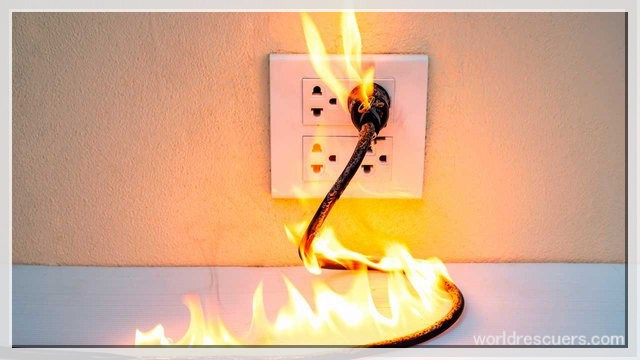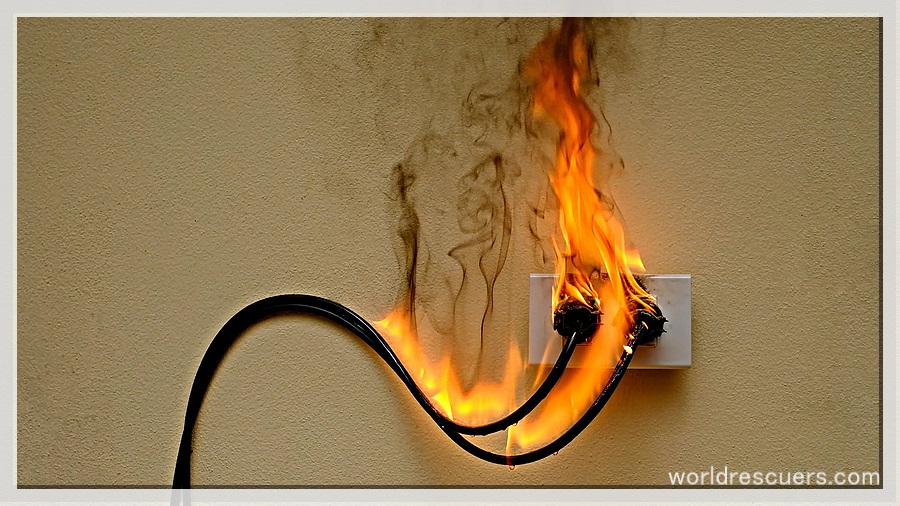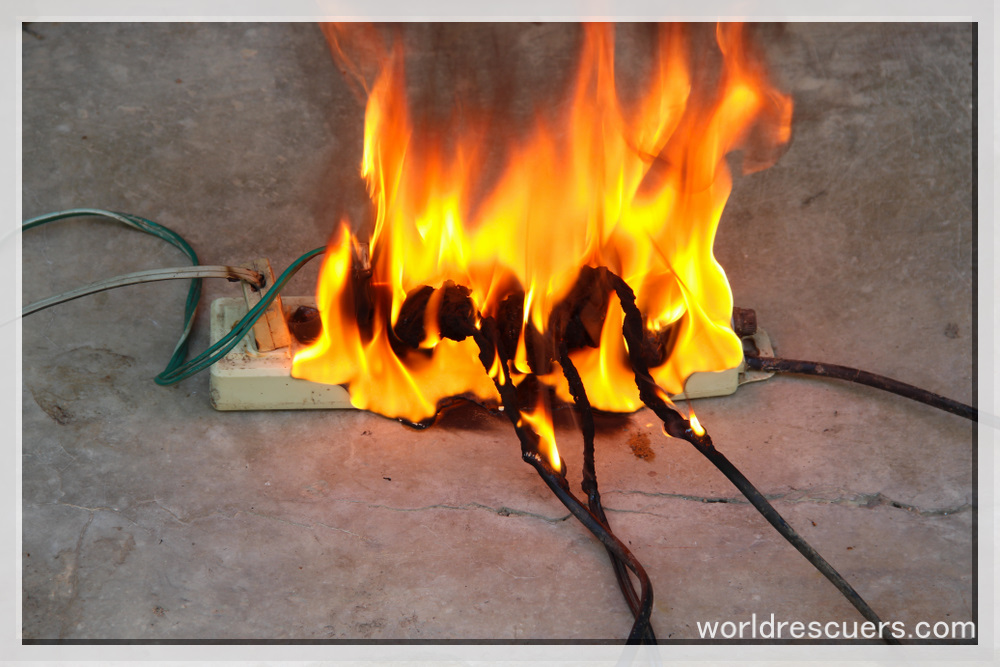
Electrical Fire
An electrical fire can be a hazardous situation. If you are not careful, it can spread and cause severe damage to your home and property. However, there are a few things that you can do to put out an electrical fire before it gets out of control. Electrical fires are a common occurrence in the home. They can be caused by faulty wiring, overloaded circuits, or an appliance that has been left on too long. The best way to put out an electrical fire is to turn off the power before it spreads and makes sure nobody is in the area of danger.

If you see sparks from an appliance, switch it off immediately and disconnect it from the power supply. If you have a fire extinguisher on hand, use it to put out the flames. Otherwise, use a blanket or rug to smother the flames and avoid spreading them further.
IF AN ELECTRICAL FIRE STARTS
The best thing to do in an electrical fire is to get out of the building as quickly as possible. If you can’t get out, use a dry chemical fire extinguisher or call the fire brigade.
An electrical fire is a dangerous situation. Electrical fires are caused by faulty wiring, overloading circuits, and other electrical malfunctions. If you encounter an electrical fire, you should follow these six steps to put it out as quickly as possible.
1: Shut off the power supply.
2: Remove any objects that might be in the way of the flames.
3: Extinguish any nearby sources of heat.
4: Prevent airflow from feeding the fire by blocking off any air vents or windows that might be near the fire.
5: Extinguish all remaining sources of flame with a fire extinguisher or blanket.
6: Call emergency services using the firefighter app.
In the event of an electrical fire in the kitchen, you should never use water to put out the fire. The electricity and water create a deadly combination that will result in electrocution. Instead, use a kitchen fire extinguisher or cover the area with a thick layer of baking soda or sand.
HOW TO STOP AN ELECTRICAL FIRE FROM OCCURRING
Electrical fires are common in the United States and can have devastating effects. This article will discuss what causes an electrical fire, how to prevent it, and what to do if you find yourself in an emergency.
Home Electrical Safety Precautions
As we all know, electricity is essential in our homes. It powers our lights and appliances and allows us to stay connected. However, electricity can also be dangerous if not used properly. That’s why it is taking some simple precautions is essential to keep you and your family safe.
Here are a few tips to follow:
1. Use the proper light bulbs in all of your fixtures.
2. Keep electrical cords and wires in good condition and away from high traffic areas.
3. Do not overload outlets or extension cords.
4. If you must use extension cords, ensure they are heavy-duty.
5. Unplug appliances when they are not in use.
6. Do not stand on wet ground when using electrical appliances outdoors.
7. If there is a power outage, use flashlights instead of candles to avoid fire risk.

Smoke Alarms
If you’re a smoker, you know the drill: open a window, step outside, and light up. But did you know that smoking inside your home is just as harmful to your family’s health as smoking in public? In fact, according to the Centers for Disease Control and Prevention (CDC), smoking in the home is the leading cause of preventable fires in the United States.
Smoke alarms are essential to any home fire safety plan and can significantly reduce the chances of injury or death in a fire. However, many people don’t realize that smoke alarms need to be replaced every ten years. That’s why it’s essential to check the manufacture date on your smoke alarms and replace them as needed.
If you don’t have smoke alarms in your home, or if they’re more than ten years old, now is the time to take action. Smoke alarms are inexpensive and easy to install, so there’s no excuse not to have them. Your family’s safety is worth the effort!
Protecting Your Home from Overcurrents
Like most people, you probably don’t think about overcurrents very often. But if you’re not careful, they can cause severe damage to your home. Overcurrents occur when the flow of electricity exceeds the circuit’s capacity. It can happen for several reasons, including faulty wiring, overloaded circuits, and damaged electrical appliances.
While overcurrents are relatively rare, they can have devastating consequences. In addition to causing fires and damaging electrical equipment, overcurrents can lead to severe injuries or even death. That’s why it’s essential to be aware of the dangers of overcurrents and take steps to protect your home from them.
Here are a few tips:
– Inspect your electrical wiring regularly and have it professionally checked if you suspect any problems.
– Don’t overload circuits by plugging in too many electrical devices simultaneously.
– Be careful with electrical appliances that generate a lot of heat, such as hair dryers and space heaters.
– Never use extension cords for high-powered devices like air conditioners or refrigerators.
– Use surge protectors for sensitive electronics, such as computers and TVs.
Outlets and Plugs
If you’re anything like us, you’re constantly searching for outlets and plugs whenever you’re in a new place. Whether at the airport or a friend’s house, keeping track of all the different types of outlets and plugs can be a pain. Thankfully, our blog section is here to help! In this section, we’ll discuss all things related to outlets and plugs, including tips on how to find them, how to use them, and what to do if you don’t have one handy.

We’ll also highlight some of the best products on the market to keep your devices charged and ready to go. So whether you’re a world traveler or just looking for some helpful tips, be sure to check out our blog section on outlets and plugs!
Electrical Cords and Cables
If you’re like most people, you have a drawer or box somewhere in your home filled with a jumble of electrical cords and cables. Maybe you even have a few loose ones lying around. This blog post will take a closer look at some of the most common types of electrical cords and cables to help you make sense of it all.
First, let’s start with power cords. These are the thick, heavy-duty cords that plug into an outlet to provide power to your electronic devices. The three main types of power cords are standard, right-angle, and hospital-grade. Standard power cords are the most common and are typically used for household appliances such as lamps and microwaves. Right-angle power cords are slightly smaller and have a 90-degree angle plug, which is helpful if you need to save space or avoid blocking other outlets. Hospital-grade power cords are thicker and have a green dot on the plug, which indicates that they meet stricter safety standards. They’re often used in medical settings but can also be found in some office buildings.
Next, let’s talk about data cables. These thinner cables are used to connect devices like
Appliances
The appliances in your home are some of the essential pieces of equipment that you have. They play a vital role in making your life easier and more comfortable. That’s why it’s essential to keep them in good working condition.
One way to do this is to clean them regularly. This will help to remove any build-up of dirt and grime that can cause them to malfunction. You should also check them for any signs of wear and tear. If you spot any damage, it’s best to get it repaired as soon as possible.
It’s also a good idea to keep an eye on your appliances’ energy usage. Some models are more energy-efficient than others. If you’re not using an appliance often, it might be worth switching to a more efficient model.
By following these simple tips, you can help prolong your appliances’ life and ensure that they continue to work correctly for many years to come.
Working Near Currents
If you work with or near electrical currents, it’s essential to know the potential dangers. Currents can cause burns, muscle spasms, and even heart failure.
This blog section will discuss some of the hazards of working with electrical currents and how to stay safe. We’ll also share tips on what to do if you’re ever exposed to a current.
So whether you’re a construction worker, electrician, or someone who works around electrical equipment, read on to learn more about staying safe near currents.

Hi, I am John Smit a Captain in Fire Department City of Newyork with over years of experience in the field of Firefighting and HSE. My passion for fire safety started when I was a young boy and witnessed a neighbor’s house go up in flames along with precious lives. Since then, I had dedicated my life to ensuring the safety of buildings, properties, and individuals in case of a fire and medical emergencies.

